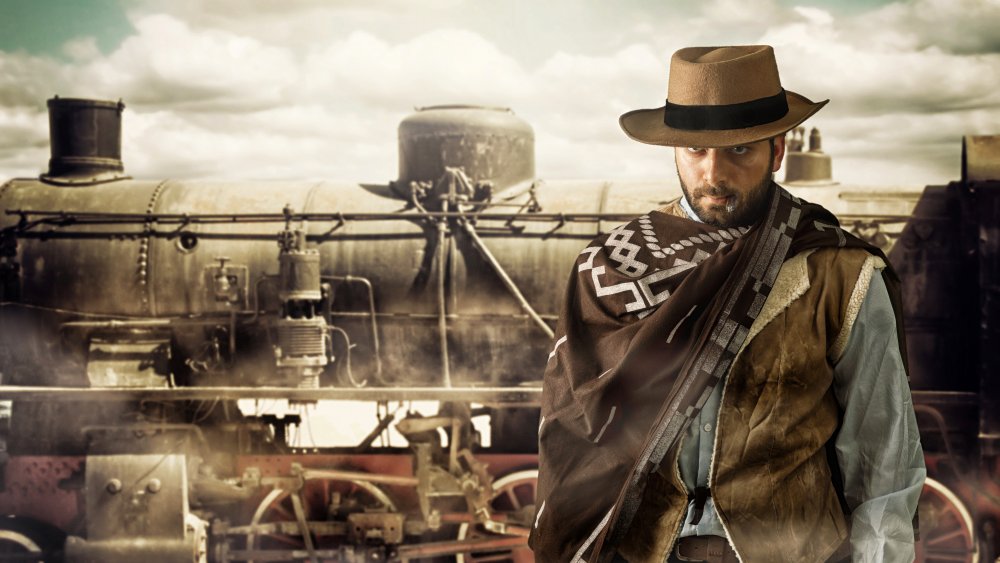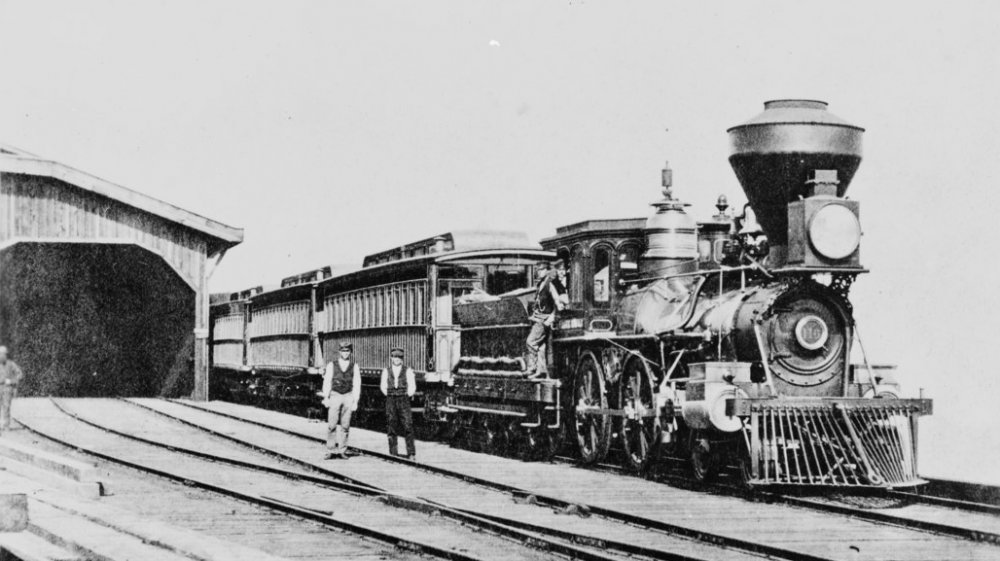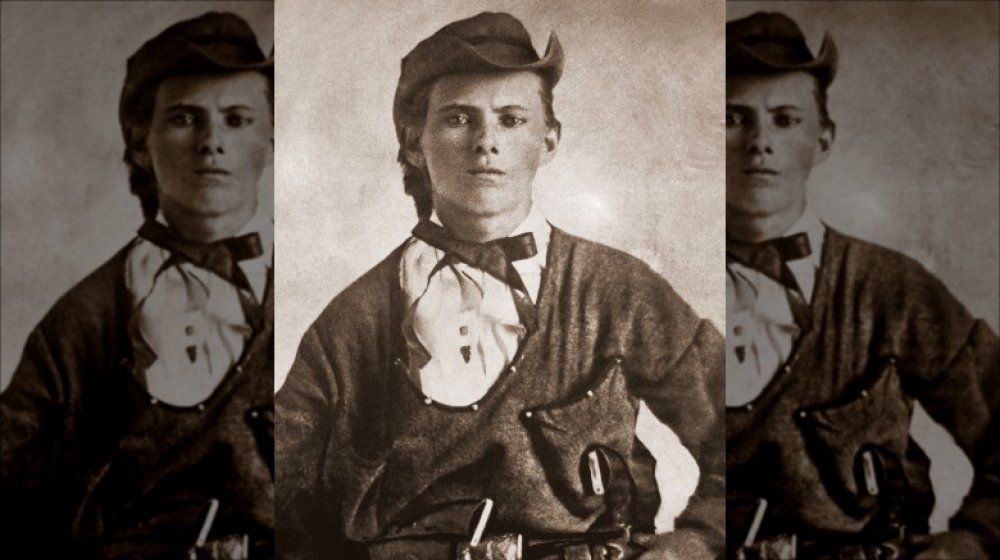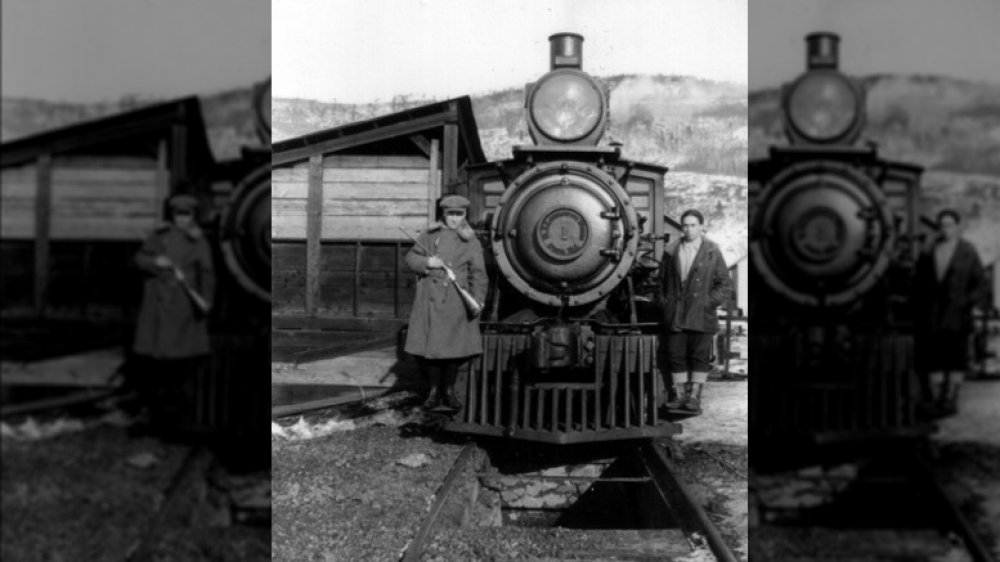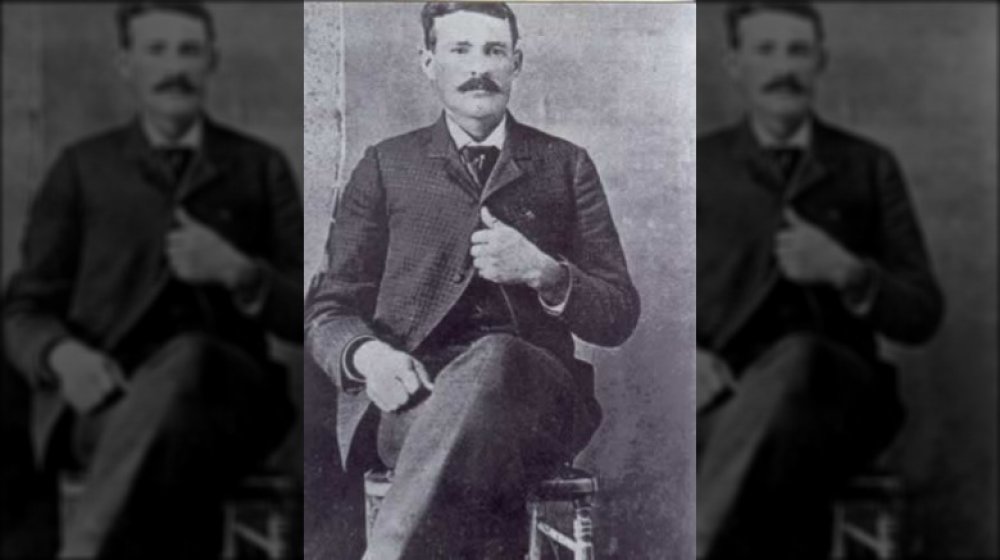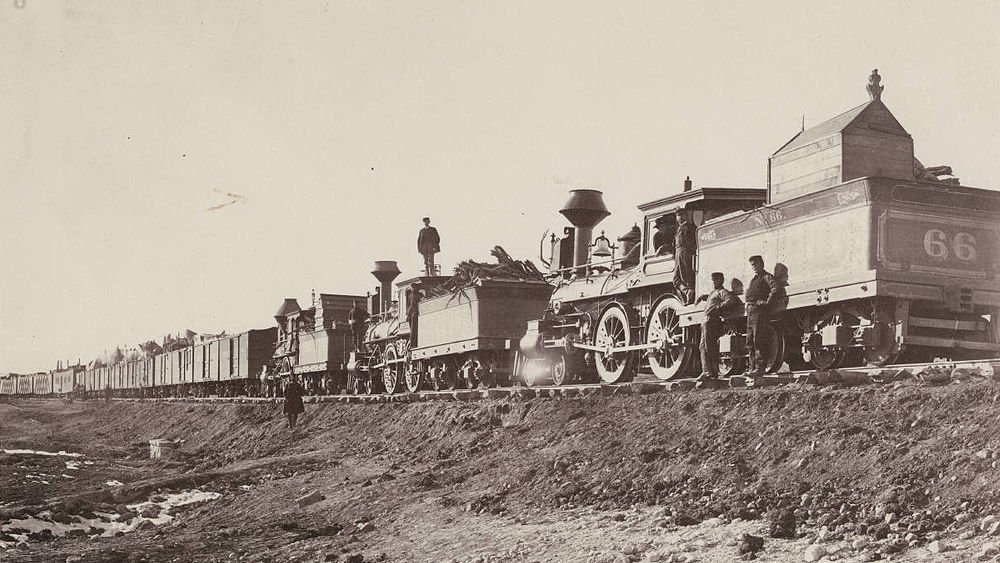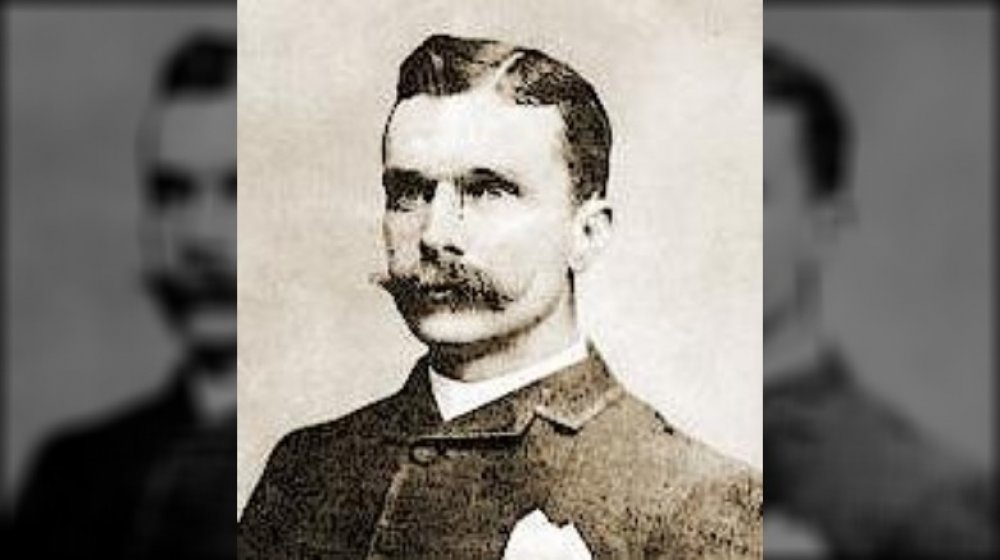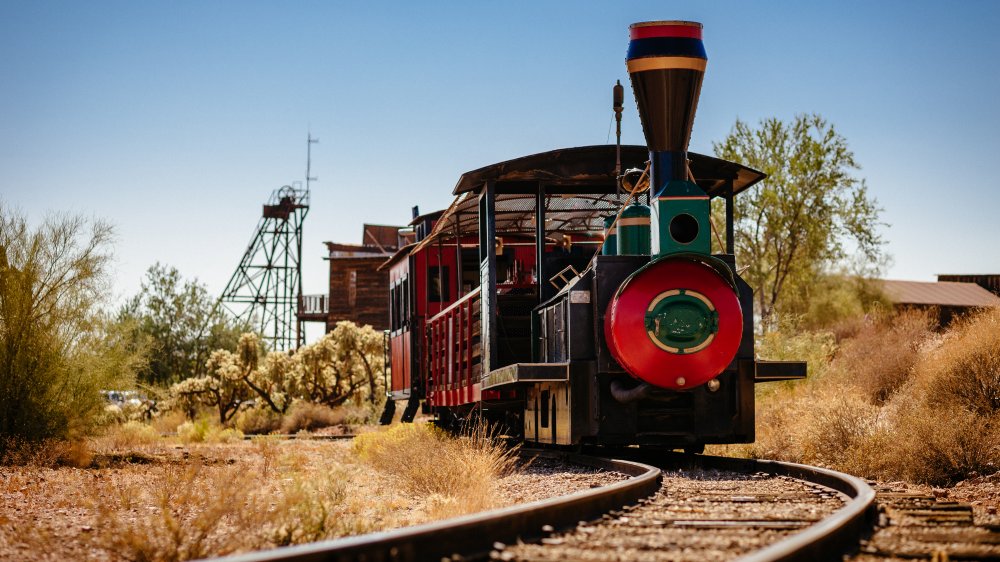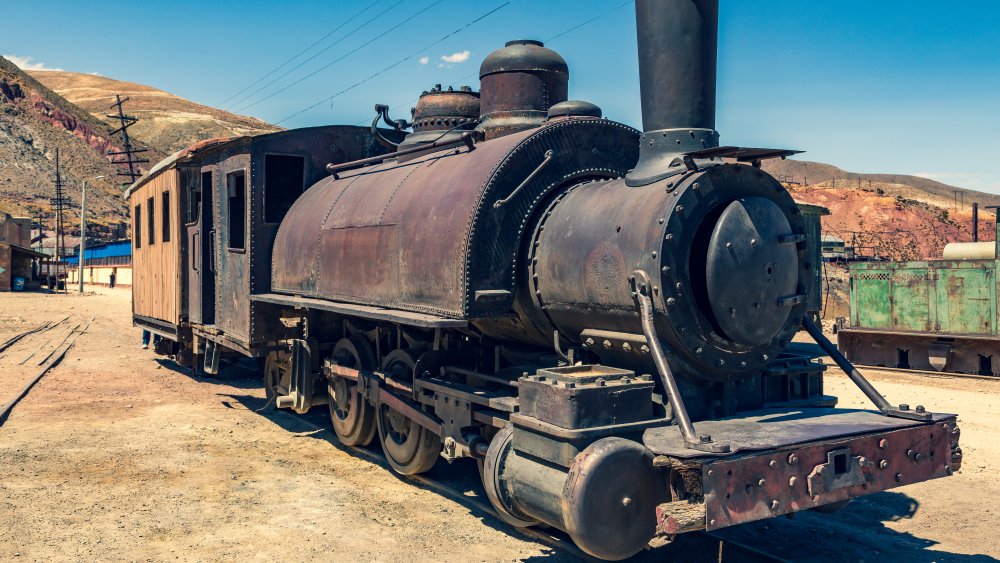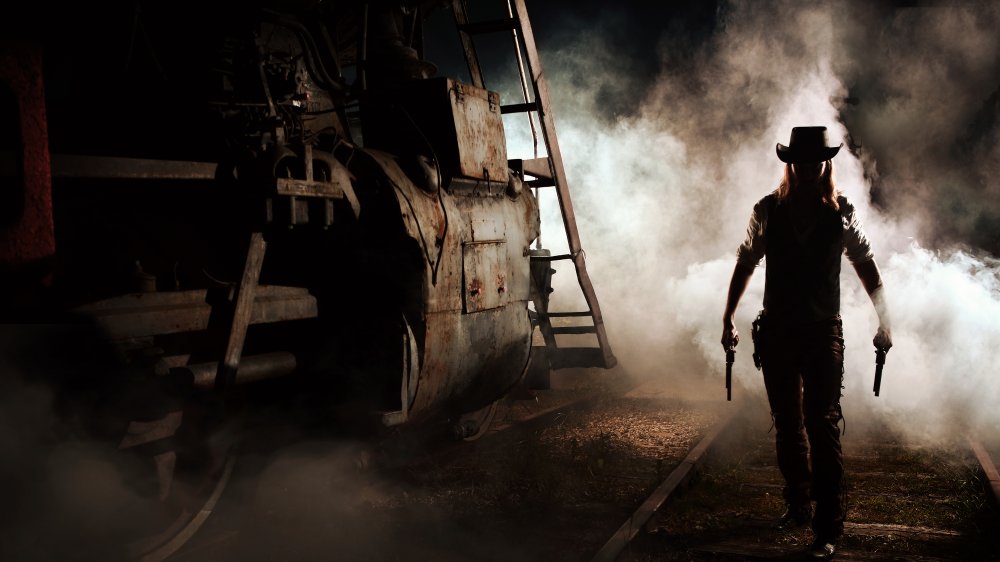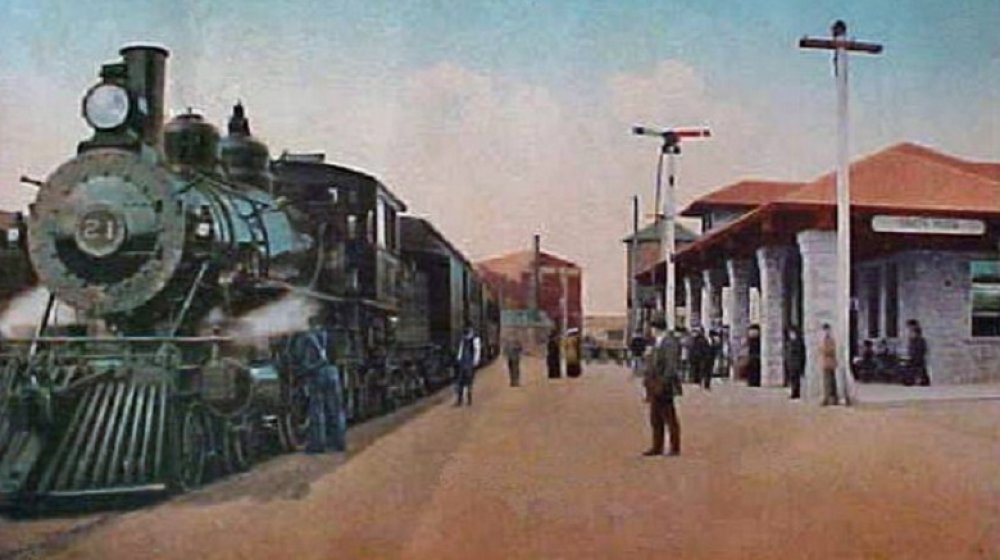The Most Notable Train Robberies In The Wild West
If you could go back in time and start life over again in the Wild West, what would you be? A train robber, right? Of course you would.
The image of the train robbers — gangs racing alongside tracks, jumping onto cars, sometimes just derailing trains altogether to break them open and get the goodies inside — is undeniably exciting. And don't forget, this was also a time in the nation's history where trains were just as important as the internet is to us today.
Railroads opened up the West: a town connected to a railroad had access to the entire continent. They transported everything from people to the essential supplies that allowed us to settle the farthest reaches of the country, and according to American Heritage, the practicality of the railroads was just one small part of it. They were important symbols, too, standing for prosperity, progress, and possibilities. It's no wonder, then, that they were tempting targets for the blossoming nation's ne'er do-wells.
The train robbery that started it all
Everything has to start somewhere, and when it comes to train robberies, the Smithsonian says that all started on October 6, 1866. That's when John and Simeon Reno carried out their admittedly pretty brilliant plan. They hopped on an Ohio & Mississippi Railroad passenger train as it passed through Indiana. Once on board, they made their way through the cars until they got to one owned by the Adams Express Company. At the time, they mainly delivered packages... and bank drafts.
The now-masked and armed robbers forced Adams employee Elem Miller to open one safe, and while they couldn't get the other open, they still got around $10,000 in gold and $33 in bank notes; then, they took off into the darkness after signaling that the train needed to stop. The conductor — none the wiser — then kept on going.
Sure, $10,000 is a lot of money, but in 1866, it was even more: adjusted for inflation, their haul was worth around $177,000. Unfortunately for the brothers, the Adams Company had a relationship with the Pinkerton Detective Agency, who almost immediately arrested them. And fortunately for them, the only witness to their crime was killed while they were out on bail and waiting for their trial. But Karma caught up to them — after an 1868 train robbery where a man died, they were hanged by a vigilante mob out for justice. Meanwhile, other outlaws realized this train robbing thing was a great idea.
Jesse James makes the jump to trains
When it comes to notorious outlaws of the Wild West, Jesse James and his gang are at the top of anyone's list. But when they made the jump to robbing trains, well, it didn't exactly go smoothly from the get-go. According to the State Historical Society of Iowa, it was 1873 when the James gang got wind of a massive shipment of gold that was on the rails. The train was going to pass through a little town called Adair on July 21, so they decided that was the perfect time to strike.
And everything went according to plan: they staked out a section of railway that was on a curve, and they severed the track. The train shot off the track, killing the engineer. The outlaws went for the safe ... but they were completely disappointed: instead of the $75,000 payday they were expecting, they scored only about $3,000 (still, adjusted for inflation, that's around $65,000). They picked up some extra cash and jewelry from the passengers then split: news traveled fast, though, and it forced them into hiding.
There are three footnotes to the story: one is that this cemented the reputation of the James gang as a group not to be trifled with. Secondly, it was the first train robbery west of the Mississippi. And third? It seems as though the train carrying the $75k passed sometime between 12 and 24 hours later — they'd robbed the wrong train.
Elmer McCurdy's oopsies: the worst train robber in the world
Some people are cut out for living a life of crime. Elmer McCurdy was not.
He was born in 1880, and headed West to get involved in some heists that, unfortunately for him, turned more into hijinks. First, he and four accomplices completely screwed up their attempt at robbing a train carrying around $4,000 — when they set off the explosives, they melted their loot. They did the same thing on their second attempt at a bank, says Ozy, and the third time was not the charm. They tried to rob a train carrying a whopping $400,000... but not only did they rob the wrong train, but McCurdy was shot in the process. He was also identified, and he was shot (again) and killed just three days later.
McCurdy's luck continued, even after death. He was embalmed by the Johnson Funeral Home, but no one came to get him... until five years later. But the man wasn't actually his brother: he was a guy who sold embalmed corpses to carnival sideshows. McCurdy changed hands a bunch of times, and it wasn't until 1977 that his corpse — which had been covered in red paint and installed at a place called Laff in the Dark by people who thought he was a mannequin — was positively identified as the unlucky robber. He was finally buried... and covered with a cement slab to guarantee his travelin' days were over.
Success is stopping before you get caught... a lesson Black Jack didn't learn
By the time he went to the gallows, he was known as Black Jack Ketchum. For years, he and his brother worked as cowboys for hire... until, says Legends of America, they learned there was a train heading their way with a lot of cash on board.
That was in 1892, and they ended up hitting the jackpot: around $20,000, or a whopping $575,000, adjusted for inflation. They escaped with it, and when the so-called Ketchum Gang showed up in New Mexico, they settled in. They hit another train in 1897 for around $60,000 in gold and silver (or almost $2 million in today's money), and yet another in 1899 for only slightly less: $50,000.
One by one, members of the gang started getting picked off, caught, or killed. Thomas Ketchum, however, decided to give it one last try — even though he was the only one left. He boarded a train, with the intention of disconnecting the mail and express cars, and walking away with still more loot. It didn't work, though: the train ended up stopping on a curve and he couldn't disconnect them. The conductor — who was being robbed for the third time — shot at him, almost severing his arm. He was captured after the failed robbery and executed: the only person decapitated in an officially sanctioned hanging in the US.
Train robbing moves even farther westward
The fine art of train robbing made it almost as far west as you could go in November of 1870. That, says Tahoe Quarterly, is when a train left San Francisco carrying the payroll of a mining operation in Virginia City, Nevada: around $41,800 in gold and silver coins (or, about $2.2 million today). It was nearing midnight when Wells Fargo guards opened the door to a sawed-off shotgun, followed by masked robbers who made short work of collecting the gold and silver. The men split their take and disappeared into the night.
So, the payroll destined for Virginia City never made it... but here's the thing: it sort of did. One of those masked men was Big Jack Davis, who wasn't your ordinary, run-of-the-mill robber — he was one of Virginia City's most upstanding and respected businessmen, who just happened to moonlight as a stagecoach robber. It was a sweet setup — he even owned his own ore-stamping mill, so he could recast whatever silver and gold he stole.
Making the jump to train robbery was just the next natural step, and his plan was pretty flawless. If it wasn't for an alert innkeeper who connected her suspicious visitors with word of the robbery, they may have even gotten away with it. Davis was arrested, served only part of his sentence after turning in a group of prisoners he saw escaping, and was shot and killed in 1877 — he had gone back to stagecoaches.
A record-setting hold-up
When it comes to famous Wild West outlaws, Sam Bass is up there, too. According to Round Rock Texas, the real Bass was a little different than the Robin Hood-like figure immortalized in song and story: for the real guy, robbing trains was just sort of... you know, a laugh. Some fun. A hoot. And it's no wonder, really: his very first robbery was — accidentally — one of the biggest.
The year was 1877, and according to South Dakota Public Broadcasting, the Black Hills Bandits hit a Union Pacific train just outside of Ogallala, Nebraska. At first, it seemed as though they'd made a horrible mistake, as the train was outfitted with a safe and secure lock that absolutely couldn't be opened until it reached its destination. If you've ever just wanted to kick something out of sheer frustration... maybe you should. One of the outlaws kicked open a wooden box, and they found $60,000 worth of gold coins. Today, that would be a haul worth around $1,460,000. The group split into pairs and headed off into the sunset forever.
Just kidding. Bass (and the members of his gang who survived) were back to train robbing the next year, and did they need it? Who knows — their haul was never recovered, and they never scored that big again.
No good deed goes unpunished
There's an old saying: no good deed goes unpunished. It's an odd one, for sure, but sometimes, it happens. According to AZ Central, it was 1889 when a group of outlaws robbed a train at the Canyon Diablo Station. The station — about 50 miles from Flagstaff — was in an area of Arizona where, well, the weather just didn't cooperate. Fresh snow was on the ground, and the tracks of the bandits were very clear. A Yavapai County Sheriff called William O'Neill gave chase, and he wasn't about to give up. He and his posse trailed them all the way into Utah, and after a shootout, the robbers were arrested.
Save one: JJ Smith. Smith hopped out of a train window and took off, making it all the way to Texas on the backs of stolen horses. And here's where the good deed comes in: along the way, he came across a woman wandering in the prairie. She was lost, confused, and hadn't eaten in days, and Smith stopped to help her. In doing so he got the attention of authorities... who promptly returned him to Arizona.
This tale comes with a bit of bad timing, too. Arizona had just decided to make train robbing a capital offense, so Smith's comrades were each handed a 25-year sentence. Smith, escapee and do-gooder, got 30 years.
The most famous train robbery of all... didn't happen like you've heard
There's been a lot of train robberies in American history, but one of the most famous is likely the robbery of the Union Pacific Overland Flyer No. 1. It was hit during the night of June 1 to 2, 1899, and the story as it's often told is the heist was pulled off by Butch Cassidy and his gang. Only according to HistoryNet, that's not precisely true.
What is true is that the train's first section was flagged down and boarded by the first group of robbers, who by the time they were done, found somewhere between $30,000 and $50,000 in bank notes, gold, cash, and jewelry. Descriptions of the perpetrators immediately went out to law enforcement, who recognized several of them as associates of Butch Cassidy. The relay-race escape route, the evasion techniques, it was all classic, but Cassidy had always maintained that he'd had nothing to do with it.
Three years prior, Cassidy had received a pardon from Wyoming's governor, on the condition that he never, ever take part in any crimes in Wyoming again. Cassidy had agreed, so while he may have gotten some of the loot and he may have joined up with the gang later, it seems likely that he did keep his word and didn't technically participate.
While the gang initially got away, they were all hunted down and killed over the next 12 years.
I ain't scared of you...!
In 1912, two men decided to rob the No. 9 Galveston, Harrisburg & San Antonio locomotive. One was a newcomer to the world of train robbery, and his name was Ole Hobek. The other was former Wild Bunch member and Butch Cassidy associate, Ben Kilpatrick. When they hopped on board the train in Dryden, Texas, Kilpatrick was coming off a 10-year stint in Atlanta and either he'd lost his edge in prison, or men on the outside had gotten a little tougher.
The train pulled away from Dryden, and that's when they stormed the engine. By this time, they were about 10 miles from the Mexican border, and their horses were waiting for them. The only one that stood in their way, says HistoryNet, was a Wells Fargo & Co. messenger named David A. Trousdale, who was not about to put up with any of this nonsense. When they ordered him to show them where the good stuff was, he deliberately misled them. Their frustration grew, and when Trousdale snagged a wooden mallet off a shipment of oysters, they didn't notice.
They should have. The first chance he got, he hit Hobek, and kept hitting him — but it only took three blows for his brains to leave his head. Taking Hobek's gun, Trousdale then started a 2-hour standoff with Kilpatrick. Trousdale only fired a single shot, and the bullet hit Kilpatrick just above the left eye. Trousdale was rewarded handsomely.
The largest train robbery in history
The biggest train robbery of them all came at the tail end of the Wild West, and fun fact? You still might be able to go treasure-hunting for some of the lost loot. Legends of America says that the Newton brothers had gotten sick of the possibility of being locked into any legit — ie. hard — work, and had turned to thievin'. They started out robbing stores, but once the various brothers all managed to not be in jail at the same time, they formed a gang and went for bigger targets: trains and banks. Between 1919 and 1924, they'd be responsible for a shocking 87 bank robberies and six train heists.
The biggest happened on June 12, 1924, when the Newtons — along with a few Chicago gangsters and a crooked postal inspector — forced a mail train to stop in Rondout. They demanded the mail sacks be thrown off the train to their waiting getaway car, scoring around $3 million. Today? That same haul would be worth around $45 million.
Most of the gang was arrested in a matter of days, save Jess Newton. He headed to Texas and came up with the brilliant idea to bury his share of the money, but later, he realized he'd been so drunk when he buried it that he had no idea where it was. It was never found, even though the brothers all looked for it after serving their time.
The long-lost loot of a Southern Pacific train
Roy Gardner, says Legends of America, was the last of his kind. He earned the title of the Last Great American Train Robber after a pretty long career that started in 1920, when he was arrested just three days after scoring a $78,000 payday robbing a mail truck. He escaped from jail, and in 1921, he hopped onto a Southern Pacific train, grabbed $187,000 in securities and cash, then hopped right off.
Today, that haul would be worth around $2.8 million, and there's still a lot of it out there. Gardener was arrested just two days after the robbery and claimed he'd "forgotten" where he buried it. What followed was a long trend of jail sentences, escapes, more train robberies, and more arrests, earning him another nickname: the King of Escape Artists. Finally, the Atlanta Federal Prison punished one of his escape attempts with 20 months in solitary, and that was followed by a stint at the St. Elizabeth Hospital for the Insane, then a transfer to Alcatraz.
Gardner was released in 1938 and committed suicide the following year. Around $250,000 of the money he stole throughout his career is still unaccounted for.
The DeAutremont Brothers' major mistake
The Southern Oregon Historical Society says that the DeAutremont brothers hated society from the day they left the womb, and in 1923, they decided to rob a train that was rumored to be carrying enough money to make them very, very wealthy men. It was the Southern Pacific Train No. 13, and at first, things went... almost all right. They boarded the train and ordered it to stop, which it did. Then, the mail clerk refused to open the car they were so focused on robbing, so they used the dynamite they brought along for just that occasion. Unfortunately, they used way, way too much dynamite, destroyed the entire car, all of the contents, and killed the mail clerk.
Along the way, they also killed a handful of the train's crew. This didn't go unnoticed, and according to UC Berkeley, this was one of the cases that led to the development of modern methods of criminology.
The manhunt for the brothers was massive, and at the forefront was UC Berkeley lecturer Edward Oscar Heinrich. Heinrich was on the cutting edge of using things like forensics, and when he was chasing the perpetrators of the botched robbery, it was evidence — like purchase records and clothing — that led him to ID'ing the suspects. And yes, they were all arrested.
